Cronody
Houses within 5km of this house
Displaying 24 houses.
Houses within 5km of Cronody
Displaying 24 houses.
| House name | Description | |
|---|---|---|
| Aglish | The Hingstons were resident at Aglish from the early 18th century. At the time of Griffith's Valuation James Hingston owned a house valued at £21 in fee. An "old mansion house" is marked on the first Ordnance Survey map at the Grid Reference W469715. The current Aglish House was built after that and appears on the 25-inch map of the 1890s. It is still extant. | |
| Farran | This house was owned by Samuel Penrose at the time of Griffith's Valuation when it was valued at £24. It was also occupied by him in 1837. In 1868 Farran was bought by William Clarke and three generations of the Clarke family lived at Farran until 1970. In 1906 the buildings were valued at £226 and Thomas Clarke was the occupier. The Irish Tourist Association Survey in the 1940s describes it as "the splendid residence of Captain Clarke, living in the Channel Islands but occupied by his relatives". The present owners offer self catering accommodation for groups. see http://www.farranhouse.com/history.htm |

|
| Leemount | Leemount was the home of Thomas Coppinger in 1814 and of Thomas Gollock in 1837. In the early 1850s this house was occupied by Thomas H. Broderick, valued at £30, and held from Thomas Gollock. In 1894 Slater refers to it as the residence of Albert Beamish. Leemount is recorded as one of the residences of John Lindsay, eldest son of George Crawford Lindsay of Moorlands, county Down in Walfords (1910). This original house was burnt in March 1921 during the War of Independence when it was the residence of Maria Lindsay, later executed as an informer by the IRA. It was replaced by the existing house. |

|
| Nadrid | A house occupied at the beginning of the 19th century by Joseph Woodley, who married Anne Baldwin in 1799 but died a few years later. By 1814 Samuel Galway was residing at Nadrid. In 1837 Henry O'Callaghan was the occupier and he was still resident at the time of Griffith's Valuation. He held the house valued at £42 from the representatives of Abraham Cross. The Irish Tourist Association survey of the 1940s refers to Nadrid as the residence of Captain Matthews. A house still remains at the site. |

|
| Rosemount | A house occupied by S. Penrose in 1814, by W. Hawkes in 1837 and Joseph R. Harding at the time of Griffith's Valuation. He held the property from John L. Westropp and the buildings were valued at £25. There is still an extant house at the site. |
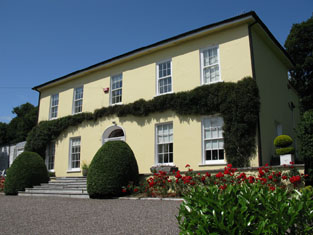
|
| Clonmoyle | In 1837 this house was the home of Charles Colthurst, a younger son of John Colthurst and his wife, Jane Bowen. At the time of Griffith's Valuation Jonathon Bruce was the occupier. He held the house valued at £35 from Charles Colthurst. Henry Leader of Clonmoyle, Coachford, owned 2,418 acres in county Cork in the 1870s. The Irish Tourist Association survey of the early 1940s mentions that it was the residence of Mrs.Young, the owner of Clonmoyle Flour Mills and that it had previously been the home of Harry Leader. It is now a ruin. | |
| Dripsey Castle | This house was the home of the descendants of John Colthurst and his wife Jane Bowen from the late 18th to the early 20th century. It is still extant though it was damaged by fire in June 1920. The Irish Tourist Association survey in the early 1940s recounts the boycotting of the family following the Sheehy-Skeffington murder in 1916 and their subsequent departure to live in England. In the early 1940s it was the property of John O'Shaughnessy who also owned Dripsey Woollen Mills. In 2014 it was offered for sale. |

|
| Beechmount | Occupied by Dr Godfrey in 1837 and by Thomas Batten who held the property from Henry Lindsey in the early 1850s. A house is still extant at the site. | |
| Hayfield | A house, offices and mill valued at £22+ was occupied by Henry Lindsey at the time of Griffith's Valuation and held from Charles Connell. In the 1940s the Irish Tourist Association survey noted that it was then occupied by the Carroll family and had been built "about 150 years ago". The original house is not extant now. | |
| Meeshal House | In 1837 Lewis describes the work done at Myshell by Dr Barter “whose demesne of 200 acres, formerly an unprofitable waste, has, since 1826, been reclaimed and brought into a state of high cultivation.” The house valued at £36 was occupied by Thomas Kenyon at the time of Griffith's Valuation and held from Henry Lindsey. In the 1940s the Irish Tourist Association survey noted that it was "formerly a Hydro before the enterprise transferred to St. Ann’s in Blarney". The National Inventory of Architectural Heritage suggests that the current house incorporates portions of the original. |

|
| Derreen | A Crooke family home in the 19th century, occupied by William Crooke in the early 1850s and held from William Furlong. The buildings were valued at £12.15 shillings. [This may possibly be the house known as Broomhill, a residence of the Cross family. Epenetus Cross of Broomhill made his will in 1776, see http://www.radleysofcork.bigpondhosting.com/My_Homepage_Files/Page2.html].) This house was offered for sale in 2010. |
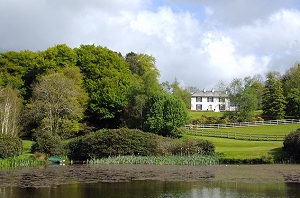
|
| Shandy Hall | The Crosses were living at Shandy from at least the late 18th century. Lewis records P. Cross as the proprietor of Shandy Hall in 1837 and Philip Cross held the house valued at £33 and 106 acres from Colonel [Mair] at the time of Griffith's Valuation. Philip Cross of Shandy Hall is recorded in 1876. The Irish Tourist Association noted that a stone inscribed with the date 1758 existed at the house and also referred to its being "the home of Phillip Cross who murdered his wife and was hanged in Cork Jail" Shandy Hall is still extant and occupied. |
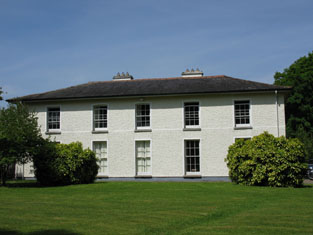
|
| Nadrid | Daniel Connor held a house in the townland of Nadrid valued at £31+ from the representatives of Abraham Cross. This may be the house known as Riversdale marked on the first Ordnance Map. In 1894 Slater refers to Nadrid House as the residence of William O'Sullivan Galgey. A house still exists at the site. | |
| Classas | A house occupied by H. Minhear in 1837 and by Lewis Gollock at the time of Griffith's Valuation when it was valued at £26 and held from William Crooke. In 1894 Slater notes it as the seat of A. McCall. In the 1940s the Irish Tourist Association survey noted that it was then being run by Mrs. Agnes Leader as a guesthouse "for relatives". It is still extant and occupied. |
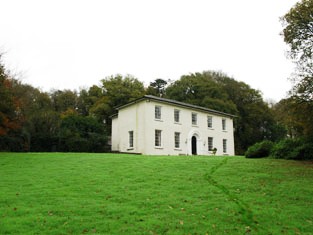
|
| Old Town | S. Crooke was residing at Old Town in 1837 and Simon D. Crooke in the early 1850s when the house was valued at £14.10 shillings and held from William Furlong. It is no longer extant. | |
| Cottage | Originally a Vize home, later occupied by the Pyne family, J. Pyne was in residence in 1814 and 1837 and the house appears to be unoccupied at the time of Griffith's Valuation, Reverend John Lawless Pine was the immediate lessor. It was valued at £17.15 shillings. | |
| Elm Park | Garyhasty was described by Smith in 1750 as the "pleasant country house" of Mr Riggs Faulkner. I A house located on the Riggs Falkiner estate, Wilson notes it as the seat of Rev. Mr. Kenney in 1786. It was occupied by Valentine Barry in 1837 and by Thomas Barry at the time of Griffith's Valuation and valued at £36. Home of Richard Ashe Orpen in the 1870s. Elm Park is still extant and occupied. |
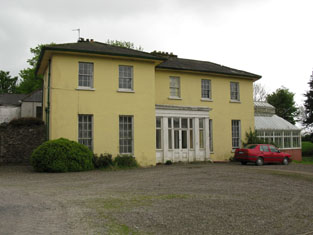
|
| Ellen Ville | This appears to be the house known as Broomhill which was a Radley residence. The house is named Ellen Ville on the first Ordnance Survey map. At the time of Griffith's Valuation Dr Thomas Godfrey was occupying Ellen Ville, valued at £14.15 shillings and held from William Furlong. | |
| Springmount | In 1837 and at the time of Griffith's Valuation this property was occupied by Samuel McCarthy. Valued at £19.10 shillings it was held from Lady Carbery's estate. There is still an extant house at the site. | |
| Clashanure | Home of a number of generations of the Allen family in the 18th and 19th centuries. Occupied by the representatives of Kyrle Allen at the time of Griffith's Valuation and held from Robert Meade. The buildings were valued at £15 and the Allens also had a mill valued at £13. Still extant and occupied. |
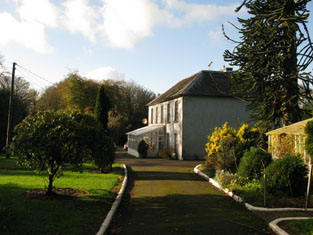
|
| Inishleena | Located on the Devonshire estate, Inishlenna Abbey was occupied by Cross Fitzgibbon at the time of Griffith's Valuation and in the 1870s. The buildings were valued at £10. The location of the Abbey is now under water as part of a reservoir. | |
| Deeshart | Denis Fielding held a house, office and mills valued at £28 from John H. Colthurst at the time of Griffith's Valuation. This may be the premises labelled "Carding Mill" on the 1st edition Ordnance Survey map and as "Dripsey Woollen Mills" on the 25-inch edition of the 1890s. Industrial buildings still exist at the site. | |
| Dripsey Lodge | At the time of Griffith's Valuation this property was occupied by Alfred Greer, leasing from Sir William Magny. The house was valued at £26 while the adjacent paper mills had a valuation of £120. It is named as Dripsey House on the 25-inch Ordnance Survey map of the 1890s. The house is no longer extant. | |
| Clontead More House | At the time of Griffith's Valuation, Herbert Gillman was leasing a property valued at £14 from Edward Murphy. This house was built after the publication of the 1st edition Ordnance Survey map. The Irish Tourist Association survey refers to "Clontead" as the former residence of the historian, Herbert Webb Gillman,(1832-1898). It is still extant and seems to have become known as Clontead More House. |

|

